QLG: Analysis of Innovation and Continuous Improvement Strategies
VerifiedAdded on 2019/10/09
|19
|4623
|336
Report
AI Summary
This report provides a comprehensive analysis of QLG's approach to managing innovation and organizational change. It begins with an environmental evaluation using SWOT and PEST analyses, identifying strengths, weaknesses, opportunities, and threats. The report then explores opportunities for change and improvement, prioritizing them and outlining strategies for testing and trialing new ideas. A detailed risk assessment and cost-benefit analysis are conducted for both change and improvement initiatives. Stakeholders are identified, and a project plan is developed, including change methodologies, resource allocation, and budget. Strategies for communicating and embedding change are discussed, along with potential barriers and solutions. The report concludes with a review of the project plan and QLG's knowledge management system, covering topics such as creativity, innovation, learning principles, quality management, sustainability, and risk management. The report explores how to promote the value of creativity, innovation, and sustainability within the organization and recognizes the impact of changes.
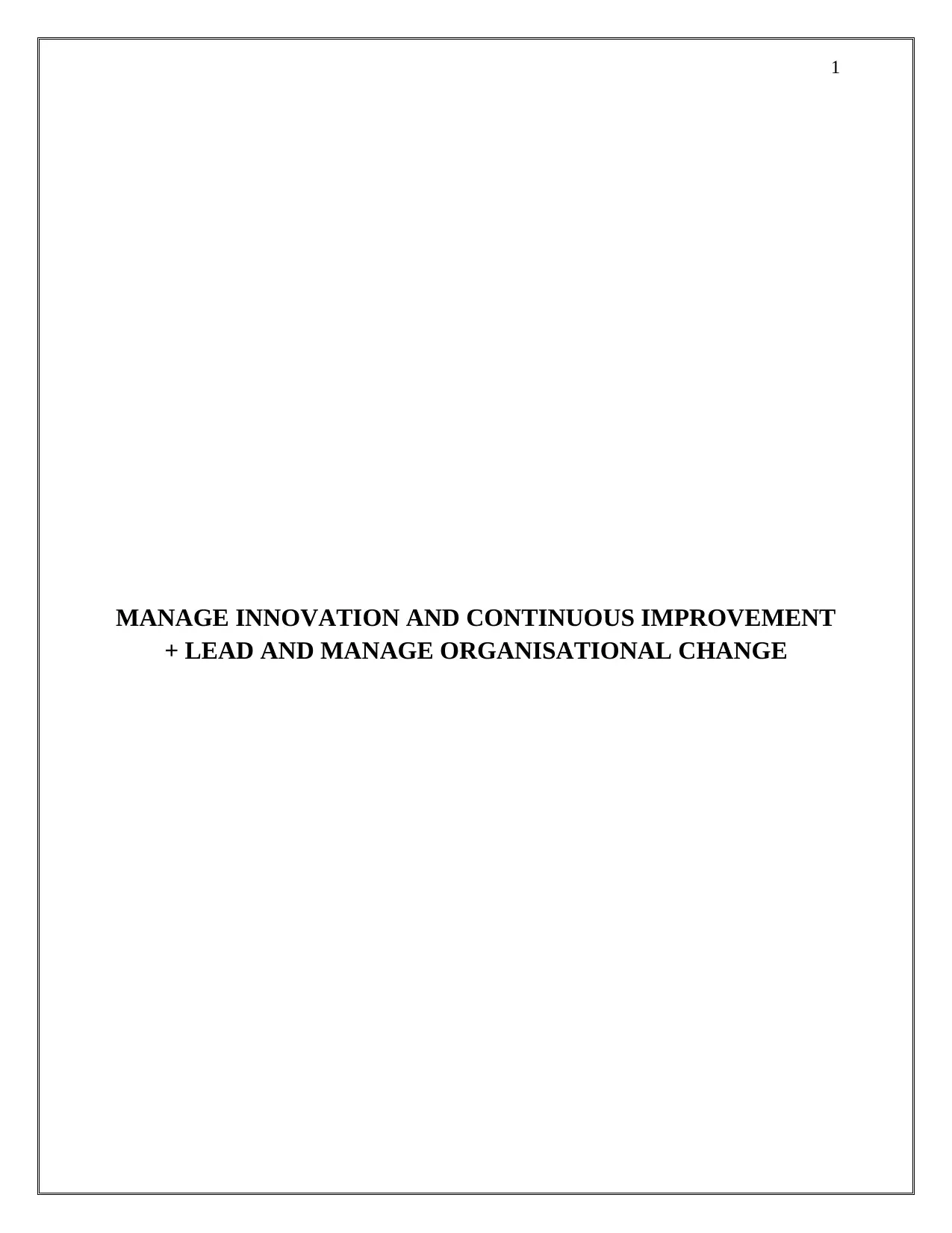
1
MANAGE INNOVATION AND CONTINUOUS IMPROVEMENT
+ LEAD AND MANAGE ORGANISATIONAL CHANGE
MANAGE INNOVATION AND CONTINUOUS IMPROVEMENT
+ LEAD AND MANAGE ORGANISATIONAL CHANGE
Paraphrase This Document
Need a fresh take? Get an instant paraphrase of this document with our AI Paraphraser
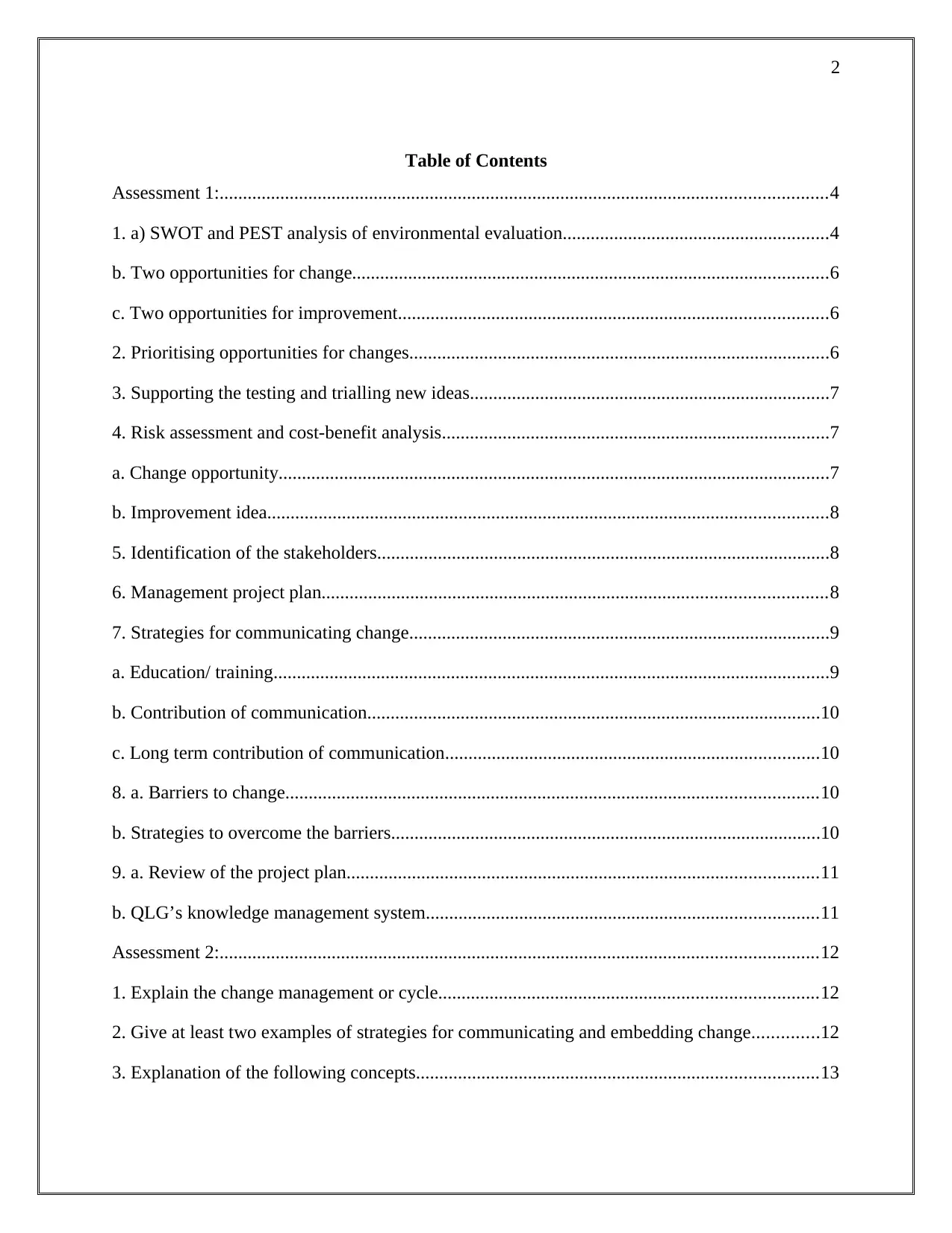
2
Table of Contents
Assessment 1:..................................................................................................................................4
1. a) SWOT and PEST analysis of environmental evaluation.........................................................4
b. Two opportunities for change......................................................................................................6
c. Two opportunities for improvement............................................................................................6
2. Prioritising opportunities for changes..........................................................................................6
3. Supporting the testing and trialling new ideas.............................................................................7
4. Risk assessment and cost-benefit analysis...................................................................................7
a. Change opportunity......................................................................................................................7
b. Improvement idea........................................................................................................................8
5. Identification of the stakeholders.................................................................................................8
6. Management project plan............................................................................................................8
7. Strategies for communicating change..........................................................................................9
a. Education/ training.......................................................................................................................9
b. Contribution of communication.................................................................................................10
c. Long term contribution of communication................................................................................10
8. a. Barriers to change..................................................................................................................10
b. Strategies to overcome the barriers............................................................................................10
9. a. Review of the project plan.....................................................................................................11
b. QLG’s knowledge management system....................................................................................11
Assessment 2:................................................................................................................................12
1. Explain the change management or cycle.................................................................................12
2. Give at least two examples of strategies for communicating and embedding change..............12
3. Explanation of the following concepts......................................................................................13
Table of Contents
Assessment 1:..................................................................................................................................4
1. a) SWOT and PEST analysis of environmental evaluation.........................................................4
b. Two opportunities for change......................................................................................................6
c. Two opportunities for improvement............................................................................................6
2. Prioritising opportunities for changes..........................................................................................6
3. Supporting the testing and trialling new ideas.............................................................................7
4. Risk assessment and cost-benefit analysis...................................................................................7
a. Change opportunity......................................................................................................................7
b. Improvement idea........................................................................................................................8
5. Identification of the stakeholders.................................................................................................8
6. Management project plan............................................................................................................8
7. Strategies for communicating change..........................................................................................9
a. Education/ training.......................................................................................................................9
b. Contribution of communication.................................................................................................10
c. Long term contribution of communication................................................................................10
8. a. Barriers to change..................................................................................................................10
b. Strategies to overcome the barriers............................................................................................10
9. a. Review of the project plan.....................................................................................................11
b. QLG’s knowledge management system....................................................................................11
Assessment 2:................................................................................................................................12
1. Explain the change management or cycle.................................................................................12
2. Give at least two examples of strategies for communicating and embedding change..............12
3. Explanation of the following concepts......................................................................................13
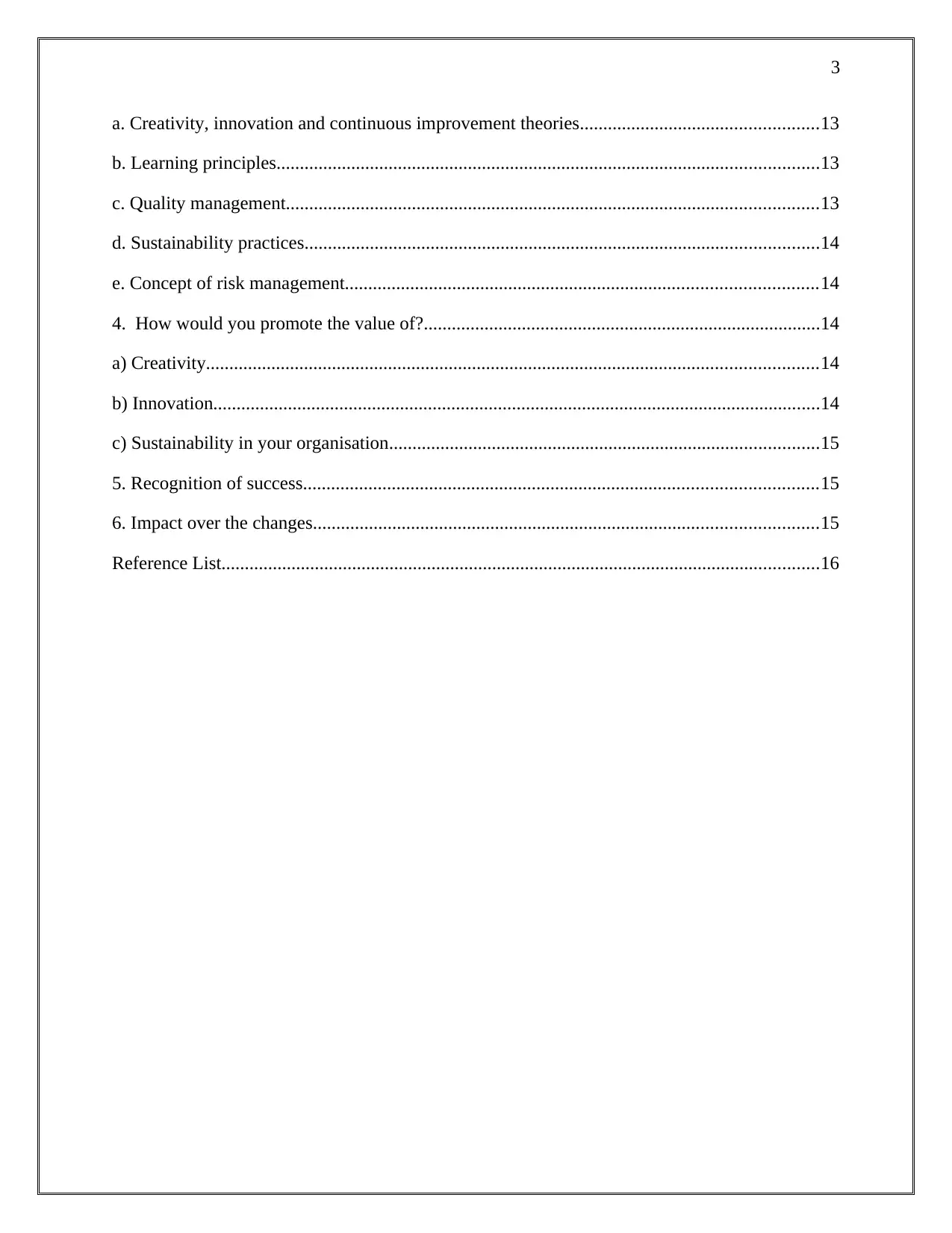
3
a. Creativity, innovation and continuous improvement theories...................................................13
b. Learning principles....................................................................................................................13
c. Quality management..................................................................................................................13
d. Sustainability practices..............................................................................................................14
e. Concept of risk management.....................................................................................................14
4. How would you promote the value of?.....................................................................................14
a) Creativity...................................................................................................................................14
b) Innovation..................................................................................................................................14
c) Sustainability in your organisation............................................................................................15
5. Recognition of success..............................................................................................................15
6. Impact over the changes............................................................................................................15
Reference List................................................................................................................................16
a. Creativity, innovation and continuous improvement theories...................................................13
b. Learning principles....................................................................................................................13
c. Quality management..................................................................................................................13
d. Sustainability practices..............................................................................................................14
e. Concept of risk management.....................................................................................................14
4. How would you promote the value of?.....................................................................................14
a) Creativity...................................................................................................................................14
b) Innovation..................................................................................................................................14
c) Sustainability in your organisation............................................................................................15
5. Recognition of success..............................................................................................................15
6. Impact over the changes............................................................................................................15
Reference List................................................................................................................................16
⊘ This is a preview!⊘
Do you want full access?
Subscribe today to unlock all pages.

Trusted by 1+ million students worldwide
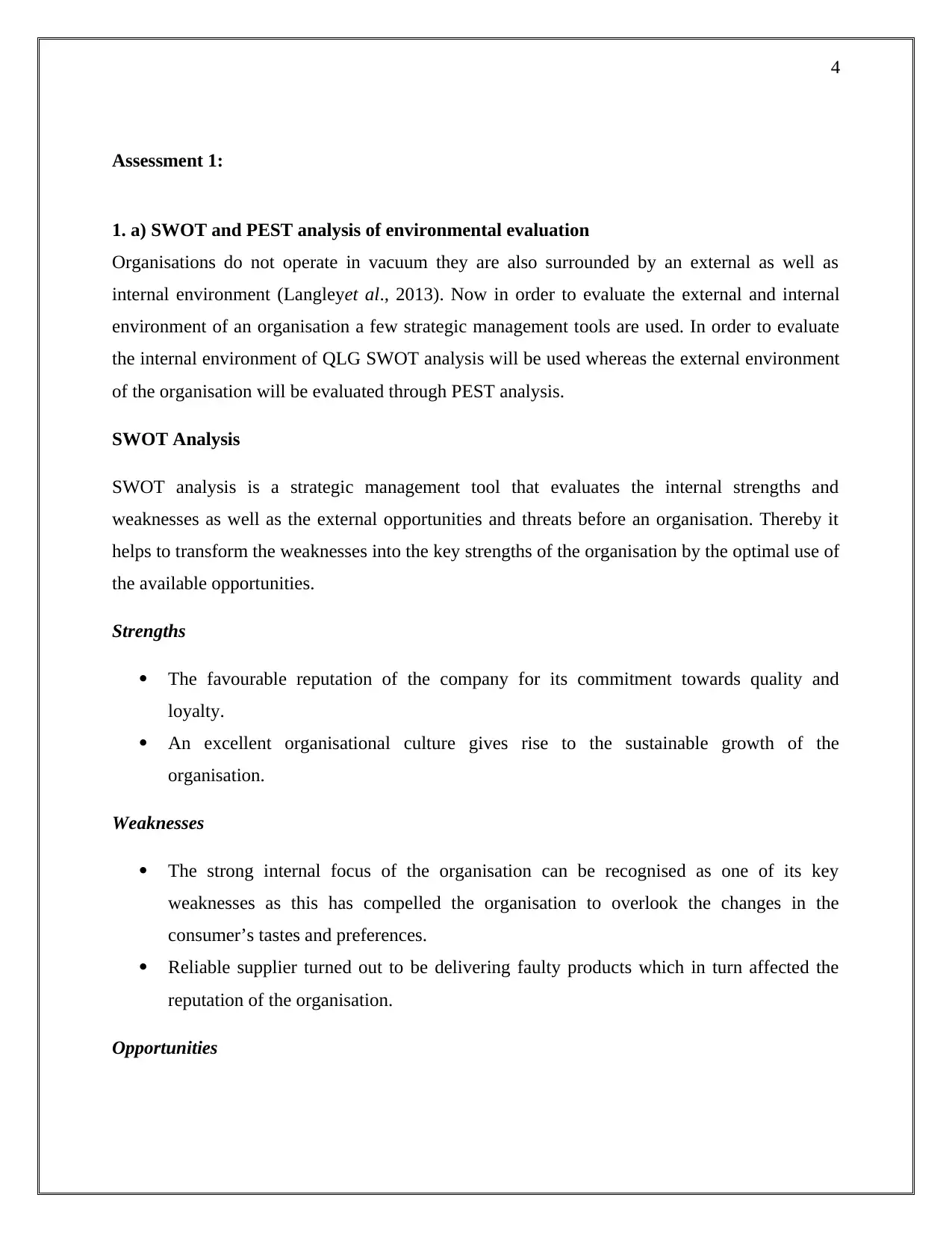
4
Assessment 1:
1. a) SWOT and PEST analysis of environmental evaluation
Organisations do not operate in vacuum they are also surrounded by an external as well as
internal environment (Langleyet al., 2013). Now in order to evaluate the external and internal
environment of an organisation a few strategic management tools are used. In order to evaluate
the internal environment of QLG SWOT analysis will be used whereas the external environment
of the organisation will be evaluated through PEST analysis.
SWOT Analysis
SWOT analysis is a strategic management tool that evaluates the internal strengths and
weaknesses as well as the external opportunities and threats before an organisation. Thereby it
helps to transform the weaknesses into the key strengths of the organisation by the optimal use of
the available opportunities.
Strengths
The favourable reputation of the company for its commitment towards quality and
loyalty.
An excellent organisational culture gives rise to the sustainable growth of the
organisation.
Weaknesses
The strong internal focus of the organisation can be recognised as one of its key
weaknesses as this has compelled the organisation to overlook the changes in the
consumer’s tastes and preferences.
Reliable supplier turned out to be delivering faulty products which in turn affected the
reputation of the organisation.
Opportunities
Assessment 1:
1. a) SWOT and PEST analysis of environmental evaluation
Organisations do not operate in vacuum they are also surrounded by an external as well as
internal environment (Langleyet al., 2013). Now in order to evaluate the external and internal
environment of an organisation a few strategic management tools are used. In order to evaluate
the internal environment of QLG SWOT analysis will be used whereas the external environment
of the organisation will be evaluated through PEST analysis.
SWOT Analysis
SWOT analysis is a strategic management tool that evaluates the internal strengths and
weaknesses as well as the external opportunities and threats before an organisation. Thereby it
helps to transform the weaknesses into the key strengths of the organisation by the optimal use of
the available opportunities.
Strengths
The favourable reputation of the company for its commitment towards quality and
loyalty.
An excellent organisational culture gives rise to the sustainable growth of the
organisation.
Weaknesses
The strong internal focus of the organisation can be recognised as one of its key
weaknesses as this has compelled the organisation to overlook the changes in the
consumer’s tastes and preferences.
Reliable supplier turned out to be delivering faulty products which in turn affected the
reputation of the organisation.
Opportunities
Paraphrase This Document
Need a fresh take? Get an instant paraphrase of this document with our AI Paraphraser
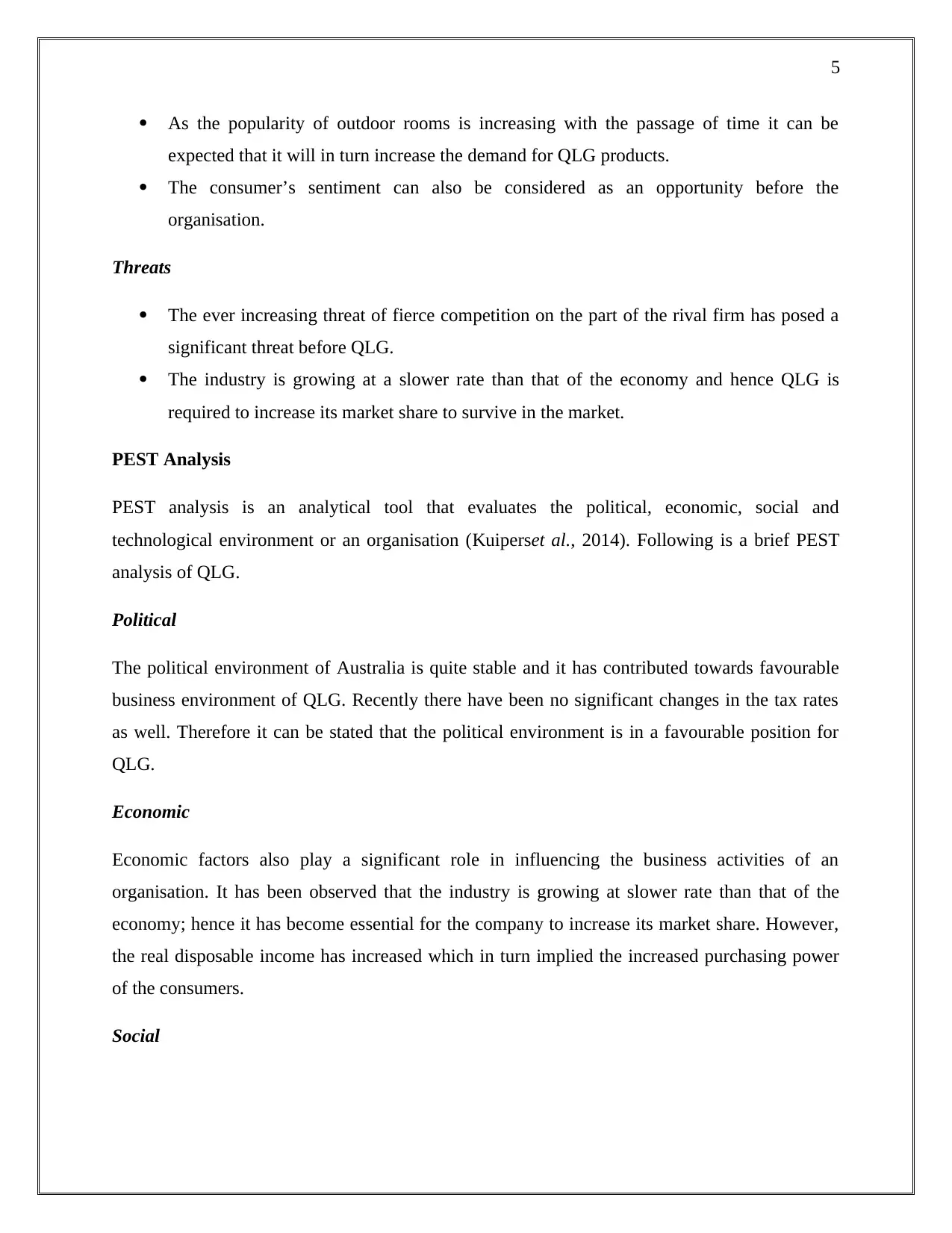
5
As the popularity of outdoor rooms is increasing with the passage of time it can be
expected that it will in turn increase the demand for QLG products.
The consumer’s sentiment can also be considered as an opportunity before the
organisation.
Threats
The ever increasing threat of fierce competition on the part of the rival firm has posed a
significant threat before QLG.
The industry is growing at a slower rate than that of the economy and hence QLG is
required to increase its market share to survive in the market.
PEST Analysis
PEST analysis is an analytical tool that evaluates the political, economic, social and
technological environment or an organisation (Kuiperset al., 2014). Following is a brief PEST
analysis of QLG.
Political
The political environment of Australia is quite stable and it has contributed towards favourable
business environment of QLG. Recently there have been no significant changes in the tax rates
as well. Therefore it can be stated that the political environment is in a favourable position for
QLG.
Economic
Economic factors also play a significant role in influencing the business activities of an
organisation. It has been observed that the industry is growing at slower rate than that of the
economy; hence it has become essential for the company to increase its market share. However,
the real disposable income has increased which in turn implied the increased purchasing power
of the consumers.
Social
As the popularity of outdoor rooms is increasing with the passage of time it can be
expected that it will in turn increase the demand for QLG products.
The consumer’s sentiment can also be considered as an opportunity before the
organisation.
Threats
The ever increasing threat of fierce competition on the part of the rival firm has posed a
significant threat before QLG.
The industry is growing at a slower rate than that of the economy and hence QLG is
required to increase its market share to survive in the market.
PEST Analysis
PEST analysis is an analytical tool that evaluates the political, economic, social and
technological environment or an organisation (Kuiperset al., 2014). Following is a brief PEST
analysis of QLG.
Political
The political environment of Australia is quite stable and it has contributed towards favourable
business environment of QLG. Recently there have been no significant changes in the tax rates
as well. Therefore it can be stated that the political environment is in a favourable position for
QLG.
Economic
Economic factors also play a significant role in influencing the business activities of an
organisation. It has been observed that the industry is growing at slower rate than that of the
economy; hence it has become essential for the company to increase its market share. However,
the real disposable income has increased which in turn implied the increased purchasing power
of the consumers.
Social
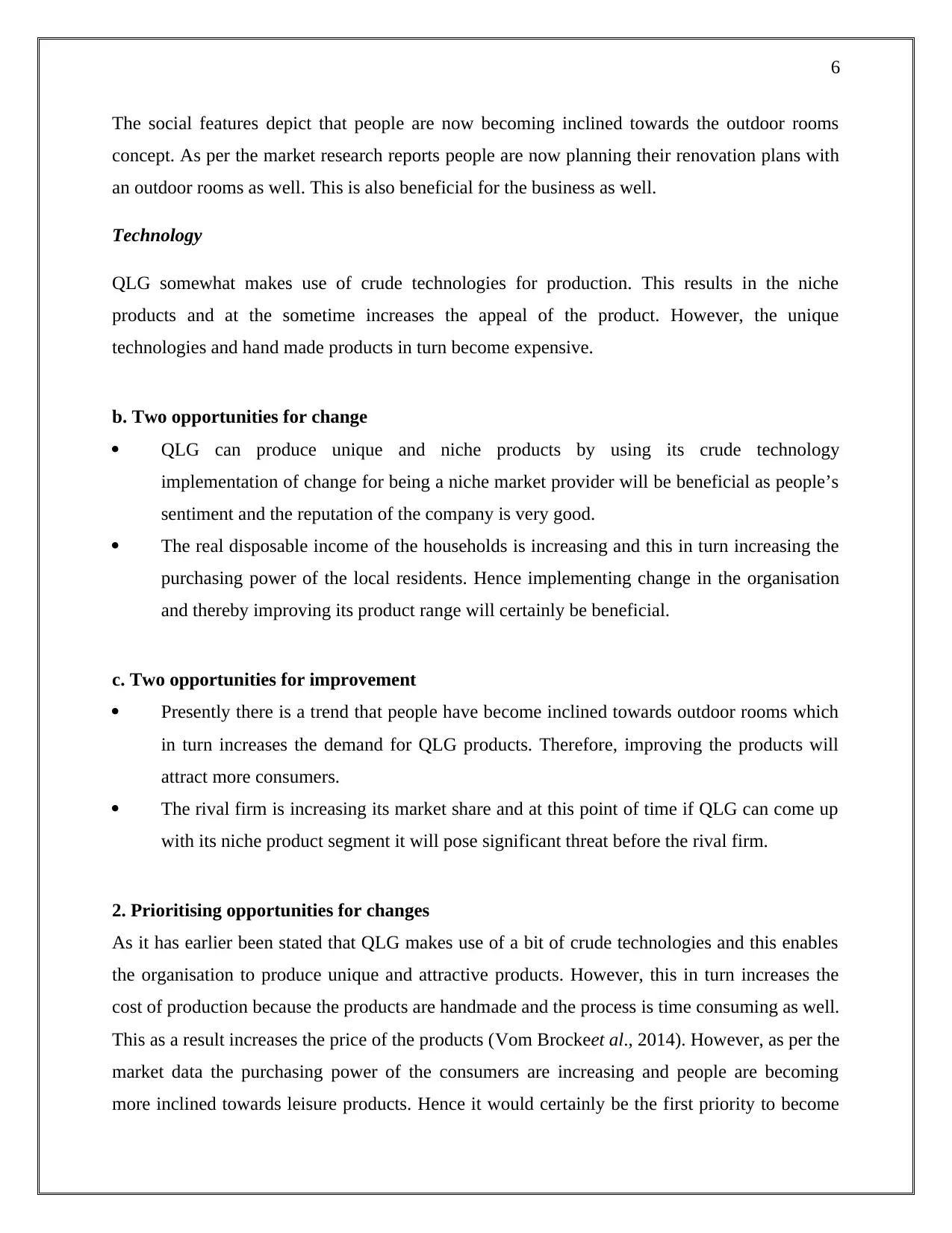
6
The social features depict that people are now becoming inclined towards the outdoor rooms
concept. As per the market research reports people are now planning their renovation plans with
an outdoor rooms as well. This is also beneficial for the business as well.
Technology
QLG somewhat makes use of crude technologies for production. This results in the niche
products and at the sometime increases the appeal of the product. However, the unique
technologies and hand made products in turn become expensive.
b. Two opportunities for change
QLG can produce unique and niche products by using its crude technology
implementation of change for being a niche market provider will be beneficial as people’s
sentiment and the reputation of the company is very good.
The real disposable income of the households is increasing and this in turn increasing the
purchasing power of the local residents. Hence implementing change in the organisation
and thereby improving its product range will certainly be beneficial.
c. Two opportunities for improvement
Presently there is a trend that people have become inclined towards outdoor rooms which
in turn increases the demand for QLG products. Therefore, improving the products will
attract more consumers.
The rival firm is increasing its market share and at this point of time if QLG can come up
with its niche product segment it will pose significant threat before the rival firm.
2. Prioritising opportunities for changes
As it has earlier been stated that QLG makes use of a bit of crude technologies and this enables
the organisation to produce unique and attractive products. However, this in turn increases the
cost of production because the products are handmade and the process is time consuming as well.
This as a result increases the price of the products (Vom Brockeet al., 2014). However, as per the
market data the purchasing power of the consumers are increasing and people are becoming
more inclined towards leisure products. Hence it would certainly be the first priority to become
The social features depict that people are now becoming inclined towards the outdoor rooms
concept. As per the market research reports people are now planning their renovation plans with
an outdoor rooms as well. This is also beneficial for the business as well.
Technology
QLG somewhat makes use of crude technologies for production. This results in the niche
products and at the sometime increases the appeal of the product. However, the unique
technologies and hand made products in turn become expensive.
b. Two opportunities for change
QLG can produce unique and niche products by using its crude technology
implementation of change for being a niche market provider will be beneficial as people’s
sentiment and the reputation of the company is very good.
The real disposable income of the households is increasing and this in turn increasing the
purchasing power of the local residents. Hence implementing change in the organisation
and thereby improving its product range will certainly be beneficial.
c. Two opportunities for improvement
Presently there is a trend that people have become inclined towards outdoor rooms which
in turn increases the demand for QLG products. Therefore, improving the products will
attract more consumers.
The rival firm is increasing its market share and at this point of time if QLG can come up
with its niche product segment it will pose significant threat before the rival firm.
2. Prioritising opportunities for changes
As it has earlier been stated that QLG makes use of a bit of crude technologies and this enables
the organisation to produce unique and attractive products. However, this in turn increases the
cost of production because the products are handmade and the process is time consuming as well.
This as a result increases the price of the products (Vom Brockeet al., 2014). However, as per the
market data the purchasing power of the consumers are increasing and people are becoming
more inclined towards leisure products. Hence it would certainly be the first priority to become
⊘ This is a preview!⊘
Do you want full access?
Subscribe today to unlock all pages.

Trusted by 1+ million students worldwide
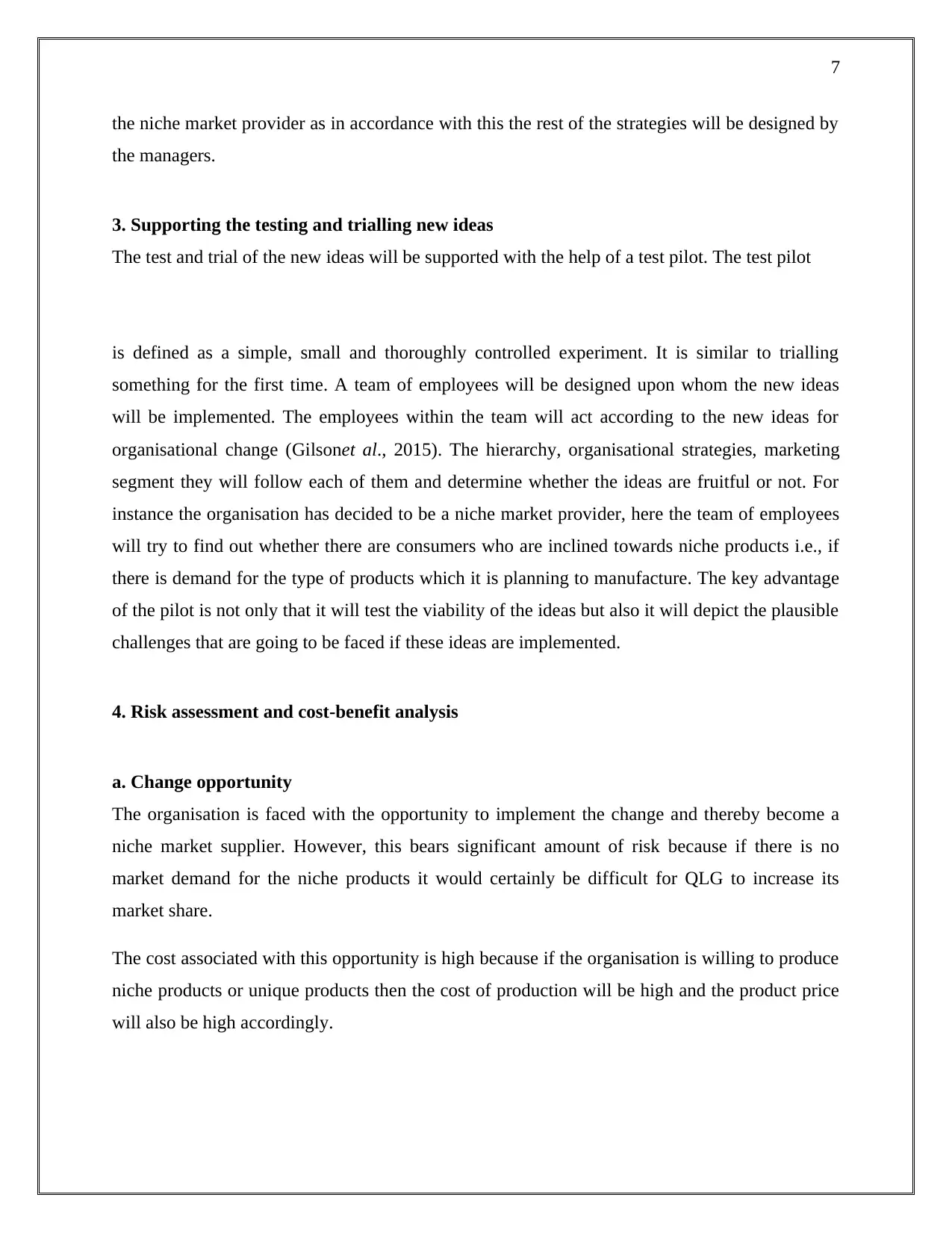
7
the niche market provider as in accordance with this the rest of the strategies will be designed by
the managers.
3. Supporting the testing and trialling new ideas
The test and trial of the new ideas will be supported with the help of a test pilot. The test pilot
is defined as a simple, small and thoroughly controlled experiment. It is similar to trialling
something for the first time. A team of employees will be designed upon whom the new ideas
will be implemented. The employees within the team will act according to the new ideas for
organisational change (Gilsonet al., 2015). The hierarchy, organisational strategies, marketing
segment they will follow each of them and determine whether the ideas are fruitful or not. For
instance the organisation has decided to be a niche market provider, here the team of employees
will try to find out whether there are consumers who are inclined towards niche products i.e., if
there is demand for the type of products which it is planning to manufacture. The key advantage
of the pilot is not only that it will test the viability of the ideas but also it will depict the plausible
challenges that are going to be faced if these ideas are implemented.
4. Risk assessment and cost-benefit analysis
a. Change opportunity
The organisation is faced with the opportunity to implement the change and thereby become a
niche market supplier. However, this bears significant amount of risk because if there is no
market demand for the niche products it would certainly be difficult for QLG to increase its
market share.
The cost associated with this opportunity is high because if the organisation is willing to produce
niche products or unique products then the cost of production will be high and the product price
will also be high accordingly.
the niche market provider as in accordance with this the rest of the strategies will be designed by
the managers.
3. Supporting the testing and trialling new ideas
The test and trial of the new ideas will be supported with the help of a test pilot. The test pilot
is defined as a simple, small and thoroughly controlled experiment. It is similar to trialling
something for the first time. A team of employees will be designed upon whom the new ideas
will be implemented. The employees within the team will act according to the new ideas for
organisational change (Gilsonet al., 2015). The hierarchy, organisational strategies, marketing
segment they will follow each of them and determine whether the ideas are fruitful or not. For
instance the organisation has decided to be a niche market provider, here the team of employees
will try to find out whether there are consumers who are inclined towards niche products i.e., if
there is demand for the type of products which it is planning to manufacture. The key advantage
of the pilot is not only that it will test the viability of the ideas but also it will depict the plausible
challenges that are going to be faced if these ideas are implemented.
4. Risk assessment and cost-benefit analysis
a. Change opportunity
The organisation is faced with the opportunity to implement the change and thereby become a
niche market supplier. However, this bears significant amount of risk because if there is no
market demand for the niche products it would certainly be difficult for QLG to increase its
market share.
The cost associated with this opportunity is high because if the organisation is willing to produce
niche products or unique products then the cost of production will be high and the product price
will also be high accordingly.
Paraphrase This Document
Need a fresh take? Get an instant paraphrase of this document with our AI Paraphraser
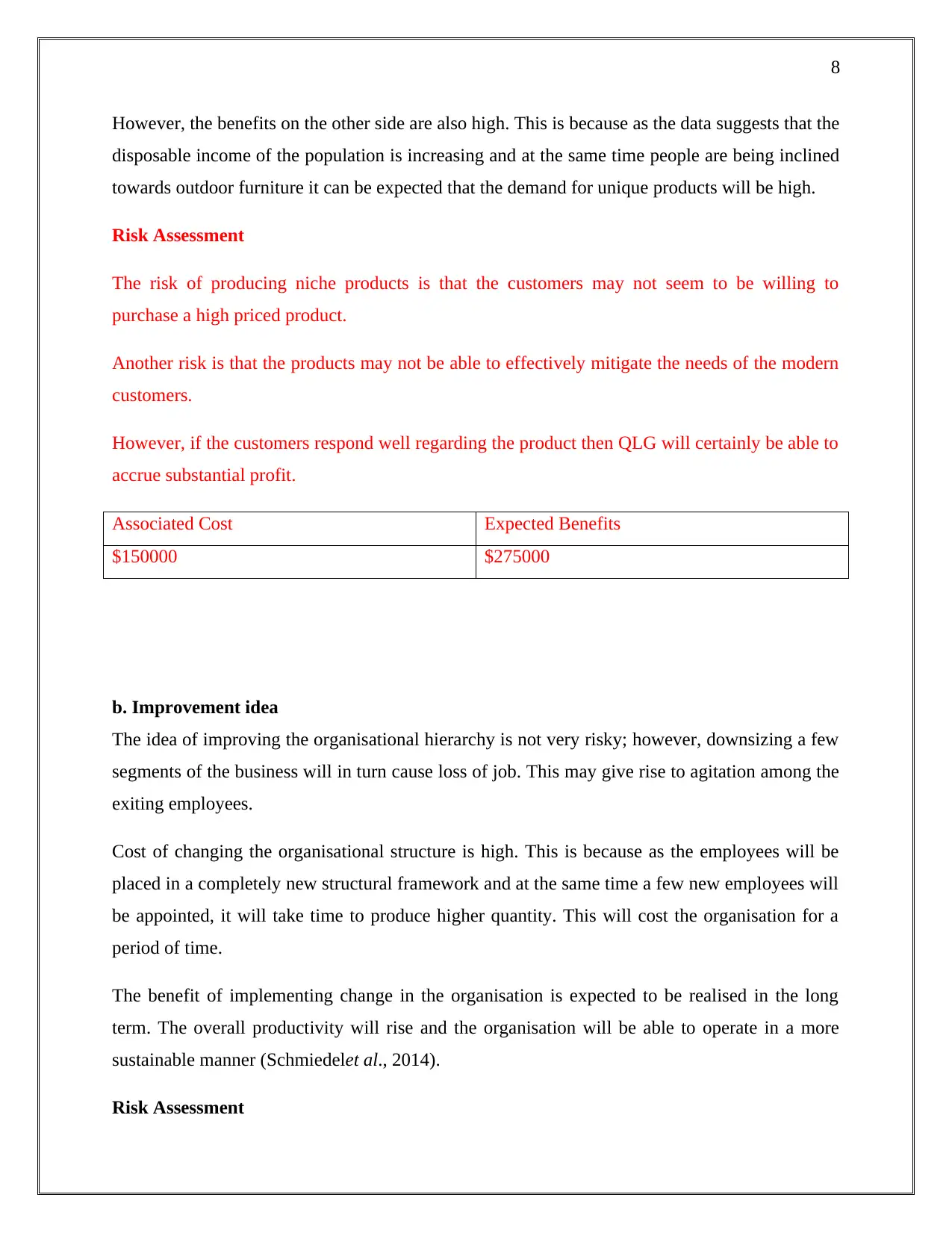
8
However, the benefits on the other side are also high. This is because as the data suggests that the
disposable income of the population is increasing and at the same time people are being inclined
towards outdoor furniture it can be expected that the demand for unique products will be high.
Risk Assessment
The risk of producing niche products is that the customers may not seem to be willing to
purchase a high priced product.
Another risk is that the products may not be able to effectively mitigate the needs of the modern
customers.
However, if the customers respond well regarding the product then QLG will certainly be able to
accrue substantial profit.
Associated Cost Expected Benefits
$150000 $275000
b. Improvement idea
The idea of improving the organisational hierarchy is not very risky; however, downsizing a few
segments of the business will in turn cause loss of job. This may give rise to agitation among the
exiting employees.
Cost of changing the organisational structure is high. This is because as the employees will be
placed in a completely new structural framework and at the same time a few new employees will
be appointed, it will take time to produce higher quantity. This will cost the organisation for a
period of time.
The benefit of implementing change in the organisation is expected to be realised in the long
term. The overall productivity will rise and the organisation will be able to operate in a more
sustainable manner (Schmiedelet al., 2014).
Risk Assessment
However, the benefits on the other side are also high. This is because as the data suggests that the
disposable income of the population is increasing and at the same time people are being inclined
towards outdoor furniture it can be expected that the demand for unique products will be high.
Risk Assessment
The risk of producing niche products is that the customers may not seem to be willing to
purchase a high priced product.
Another risk is that the products may not be able to effectively mitigate the needs of the modern
customers.
However, if the customers respond well regarding the product then QLG will certainly be able to
accrue substantial profit.
Associated Cost Expected Benefits
$150000 $275000
b. Improvement idea
The idea of improving the organisational hierarchy is not very risky; however, downsizing a few
segments of the business will in turn cause loss of job. This may give rise to agitation among the
exiting employees.
Cost of changing the organisational structure is high. This is because as the employees will be
placed in a completely new structural framework and at the same time a few new employees will
be appointed, it will take time to produce higher quantity. This will cost the organisation for a
period of time.
The benefit of implementing change in the organisation is expected to be realised in the long
term. The overall productivity will rise and the organisation will be able to operate in a more
sustainable manner (Schmiedelet al., 2014).
Risk Assessment
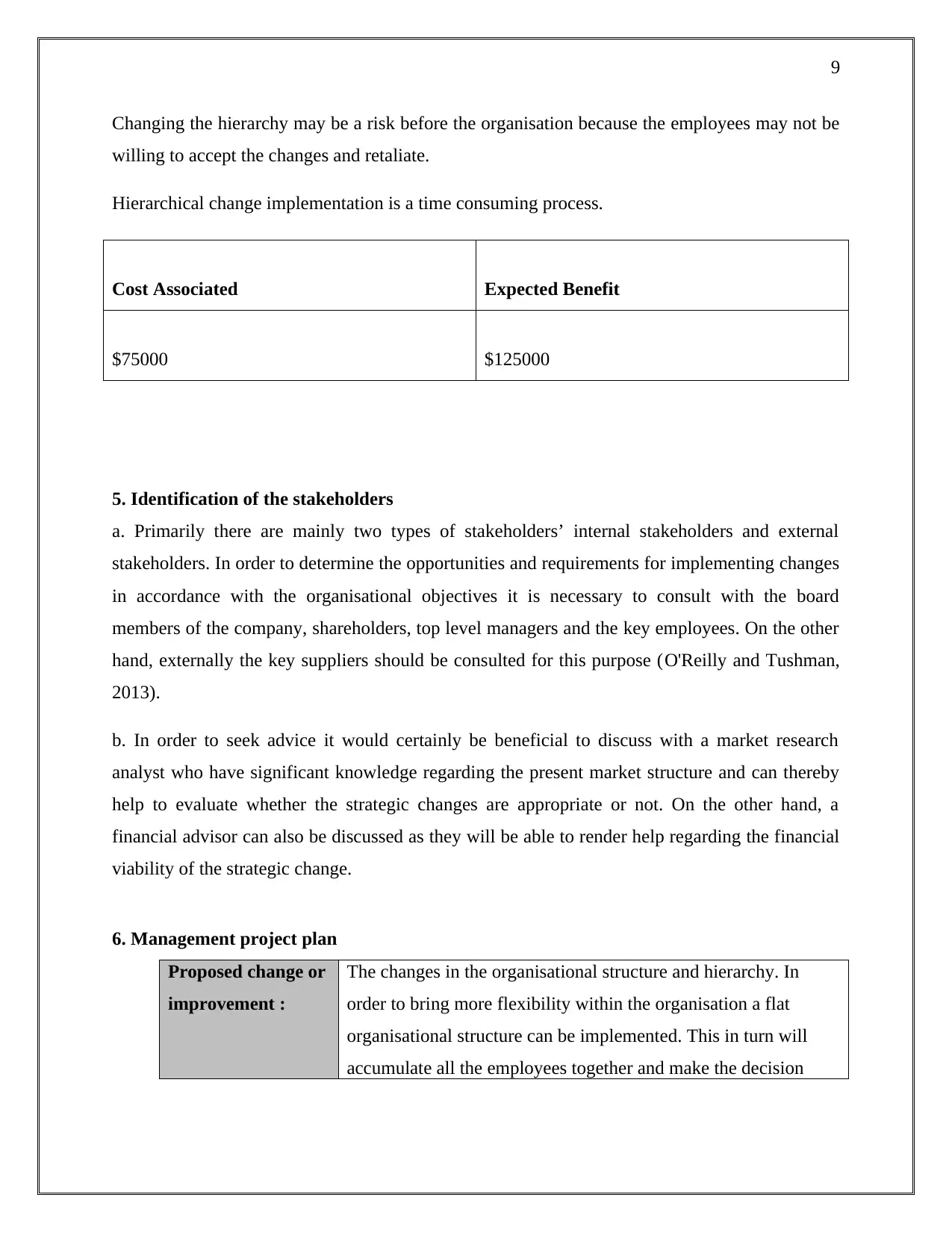
9
Changing the hierarchy may be a risk before the organisation because the employees may not be
willing to accept the changes and retaliate.
Hierarchical change implementation is a time consuming process.
Cost Associated Expected Benefit
$75000 $125000
5. Identification of the stakeholders
a. Primarily there are mainly two types of stakeholders’ internal stakeholders and external
stakeholders. In order to determine the opportunities and requirements for implementing changes
in accordance with the organisational objectives it is necessary to consult with the board
members of the company, shareholders, top level managers and the key employees. On the other
hand, externally the key suppliers should be consulted for this purpose (O'Reilly and Tushman,
2013).
b. In order to seek advice it would certainly be beneficial to discuss with a market research
analyst who have significant knowledge regarding the present market structure and can thereby
help to evaluate whether the strategic changes are appropriate or not. On the other hand, a
financial advisor can also be discussed as they will be able to render help regarding the financial
viability of the strategic change.
6. Management project plan
Proposed change or
improvement :
The changes in the organisational structure and hierarchy. In
order to bring more flexibility within the organisation a flat
organisational structure can be implemented. This in turn will
accumulate all the employees together and make the decision
Changing the hierarchy may be a risk before the organisation because the employees may not be
willing to accept the changes and retaliate.
Hierarchical change implementation is a time consuming process.
Cost Associated Expected Benefit
$75000 $125000
5. Identification of the stakeholders
a. Primarily there are mainly two types of stakeholders’ internal stakeholders and external
stakeholders. In order to determine the opportunities and requirements for implementing changes
in accordance with the organisational objectives it is necessary to consult with the board
members of the company, shareholders, top level managers and the key employees. On the other
hand, externally the key suppliers should be consulted for this purpose (O'Reilly and Tushman,
2013).
b. In order to seek advice it would certainly be beneficial to discuss with a market research
analyst who have significant knowledge regarding the present market structure and can thereby
help to evaluate whether the strategic changes are appropriate or not. On the other hand, a
financial advisor can also be discussed as they will be able to render help regarding the financial
viability of the strategic change.
6. Management project plan
Proposed change or
improvement :
The changes in the organisational structure and hierarchy. In
order to bring more flexibility within the organisation a flat
organisational structure can be implemented. This in turn will
accumulate all the employees together and make the decision
⊘ This is a preview!⊘
Do you want full access?
Subscribe today to unlock all pages.

Trusted by 1+ million students worldwide
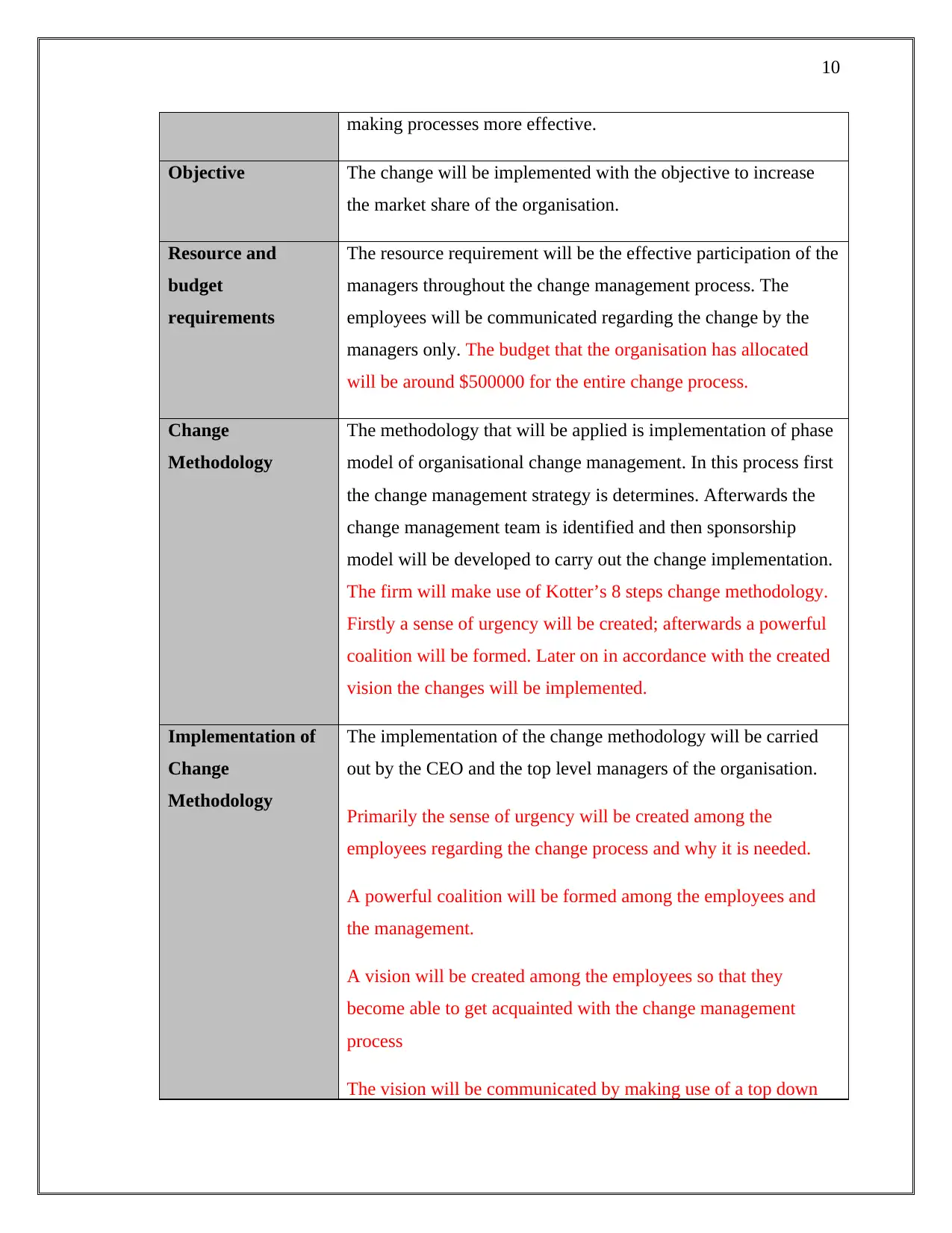
10
making processes more effective.
Objective The change will be implemented with the objective to increase
the market share of the organisation.
Resource and
budget
requirements
The resource requirement will be the effective participation of the
managers throughout the change management process. The
employees will be communicated regarding the change by the
managers only. The budget that the organisation has allocated
will be around $500000 for the entire change process.
Change
Methodology
The methodology that will be applied is implementation of phase
model of organisational change management. In this process first
the change management strategy is determines. Afterwards the
change management team is identified and then sponsorship
model will be developed to carry out the change implementation.
The firm will make use of Kotter’s 8 steps change methodology.
Firstly a sense of urgency will be created; afterwards a powerful
coalition will be formed. Later on in accordance with the created
vision the changes will be implemented.
Implementation of
Change
Methodology
The implementation of the change methodology will be carried
out by the CEO and the top level managers of the organisation.
Primarily the sense of urgency will be created among the
employees regarding the change process and why it is needed.
A powerful coalition will be formed among the employees and
the management.
A vision will be created among the employees so that they
become able to get acquainted with the change management
process
The vision will be communicated by making use of a top down
making processes more effective.
Objective The change will be implemented with the objective to increase
the market share of the organisation.
Resource and
budget
requirements
The resource requirement will be the effective participation of the
managers throughout the change management process. The
employees will be communicated regarding the change by the
managers only. The budget that the organisation has allocated
will be around $500000 for the entire change process.
Change
Methodology
The methodology that will be applied is implementation of phase
model of organisational change management. In this process first
the change management strategy is determines. Afterwards the
change management team is identified and then sponsorship
model will be developed to carry out the change implementation.
The firm will make use of Kotter’s 8 steps change methodology.
Firstly a sense of urgency will be created; afterwards a powerful
coalition will be formed. Later on in accordance with the created
vision the changes will be implemented.
Implementation of
Change
Methodology
The implementation of the change methodology will be carried
out by the CEO and the top level managers of the organisation.
Primarily the sense of urgency will be created among the
employees regarding the change process and why it is needed.
A powerful coalition will be formed among the employees and
the management.
A vision will be created among the employees so that they
become able to get acquainted with the change management
process
The vision will be communicated by making use of a top down
Paraphrase This Document
Need a fresh take? Get an instant paraphrase of this document with our AI Paraphraser
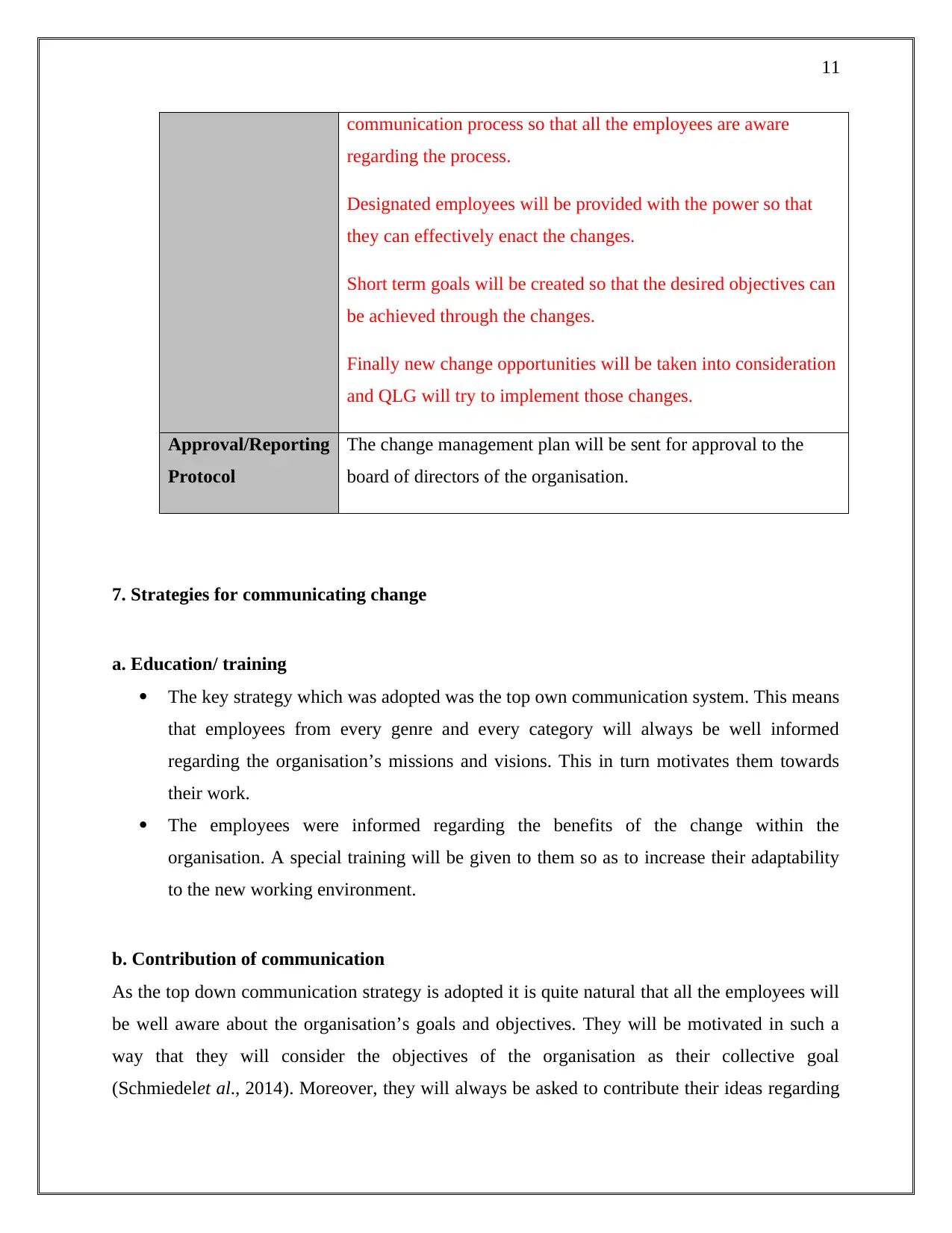
11
communication process so that all the employees are aware
regarding the process.
Designated employees will be provided with the power so that
they can effectively enact the changes.
Short term goals will be created so that the desired objectives can
be achieved through the changes.
Finally new change opportunities will be taken into consideration
and QLG will try to implement those changes.
Approval/Reporting
Protocol
The change management plan will be sent for approval to the
board of directors of the organisation.
7. Strategies for communicating change
a. Education/ training
The key strategy which was adopted was the top own communication system. This means
that employees from every genre and every category will always be well informed
regarding the organisation’s missions and visions. This in turn motivates them towards
their work.
The employees were informed regarding the benefits of the change within the
organisation. A special training will be given to them so as to increase their adaptability
to the new working environment.
b. Contribution of communication
As the top down communication strategy is adopted it is quite natural that all the employees will
be well aware about the organisation’s goals and objectives. They will be motivated in such a
way that they will consider the objectives of the organisation as their collective goal
(Schmiedelet al., 2014). Moreover, they will always be asked to contribute their ideas regarding
communication process so that all the employees are aware
regarding the process.
Designated employees will be provided with the power so that
they can effectively enact the changes.
Short term goals will be created so that the desired objectives can
be achieved through the changes.
Finally new change opportunities will be taken into consideration
and QLG will try to implement those changes.
Approval/Reporting
Protocol
The change management plan will be sent for approval to the
board of directors of the organisation.
7. Strategies for communicating change
a. Education/ training
The key strategy which was adopted was the top own communication system. This means
that employees from every genre and every category will always be well informed
regarding the organisation’s missions and visions. This in turn motivates them towards
their work.
The employees were informed regarding the benefits of the change within the
organisation. A special training will be given to them so as to increase their adaptability
to the new working environment.
b. Contribution of communication
As the top down communication strategy is adopted it is quite natural that all the employees will
be well aware about the organisation’s goals and objectives. They will be motivated in such a
way that they will consider the objectives of the organisation as their collective goal
(Schmiedelet al., 2014). Moreover, they will always be asked to contribute their ideas regarding
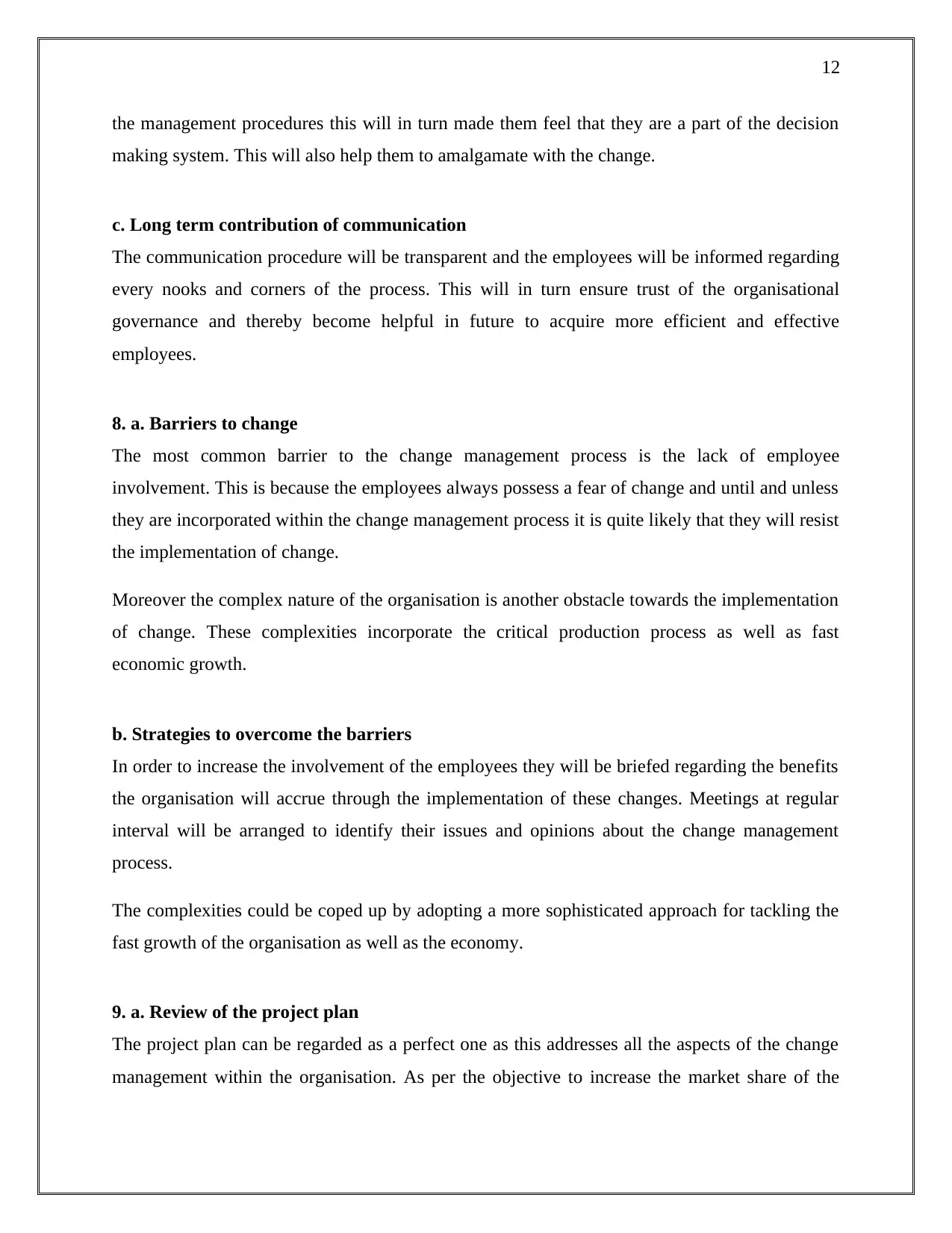
12
the management procedures this will in turn made them feel that they are a part of the decision
making system. This will also help them to amalgamate with the change.
c. Long term contribution of communication
The communication procedure will be transparent and the employees will be informed regarding
every nooks and corners of the process. This will in turn ensure trust of the organisational
governance and thereby become helpful in future to acquire more efficient and effective
employees.
8. a. Barriers to change
The most common barrier to the change management process is the lack of employee
involvement. This is because the employees always possess a fear of change and until and unless
they are incorporated within the change management process it is quite likely that they will resist
the implementation of change.
Moreover the complex nature of the organisation is another obstacle towards the implementation
of change. These complexities incorporate the critical production process as well as fast
economic growth.
b. Strategies to overcome the barriers
In order to increase the involvement of the employees they will be briefed regarding the benefits
the organisation will accrue through the implementation of these changes. Meetings at regular
interval will be arranged to identify their issues and opinions about the change management
process.
The complexities could be coped up by adopting a more sophisticated approach for tackling the
fast growth of the organisation as well as the economy.
9. a. Review of the project plan
The project plan can be regarded as a perfect one as this addresses all the aspects of the change
management within the organisation. As per the objective to increase the market share of the
the management procedures this will in turn made them feel that they are a part of the decision
making system. This will also help them to amalgamate with the change.
c. Long term contribution of communication
The communication procedure will be transparent and the employees will be informed regarding
every nooks and corners of the process. This will in turn ensure trust of the organisational
governance and thereby become helpful in future to acquire more efficient and effective
employees.
8. a. Barriers to change
The most common barrier to the change management process is the lack of employee
involvement. This is because the employees always possess a fear of change and until and unless
they are incorporated within the change management process it is quite likely that they will resist
the implementation of change.
Moreover the complex nature of the organisation is another obstacle towards the implementation
of change. These complexities incorporate the critical production process as well as fast
economic growth.
b. Strategies to overcome the barriers
In order to increase the involvement of the employees they will be briefed regarding the benefits
the organisation will accrue through the implementation of these changes. Meetings at regular
interval will be arranged to identify their issues and opinions about the change management
process.
The complexities could be coped up by adopting a more sophisticated approach for tackling the
fast growth of the organisation as well as the economy.
9. a. Review of the project plan
The project plan can be regarded as a perfect one as this addresses all the aspects of the change
management within the organisation. As per the objective to increase the market share of the
⊘ This is a preview!⊘
Do you want full access?
Subscribe today to unlock all pages.

Trusted by 1+ million students worldwide
1 out of 19
Related Documents
Your All-in-One AI-Powered Toolkit for Academic Success.
+13062052269
info@desklib.com
Available 24*7 on WhatsApp / Email
![[object Object]](/_next/static/media/star-bottom.7253800d.svg)
Unlock your academic potential
Copyright © 2020–2025 A2Z Services. All Rights Reserved. Developed and managed by ZUCOL.





